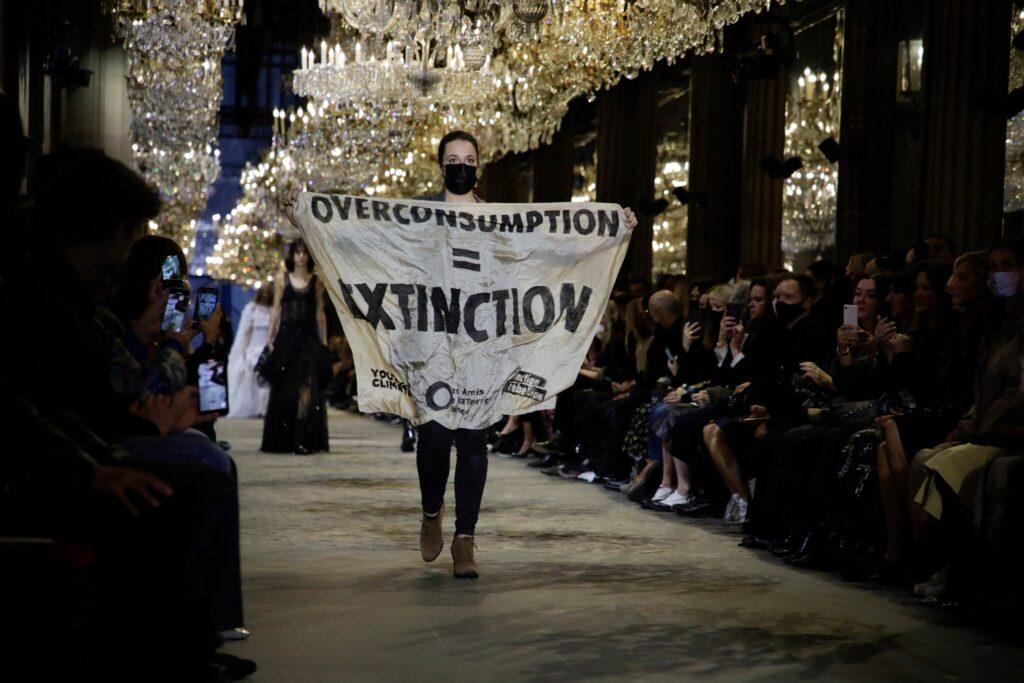As models strutted down the catwalk during the final event of Louis Vuitton’s Paris Fashion Week show on Oct. 5, activist Marie Cohuet, who is part of the environmental group “Extinction Rebellion,” disrupted the event by joining them onstage with a large banner stating “Overconsumption=Extinction.”
Although security was eventually able to sweep her away, Cohuet’s action points to a reality that some find hard to accept: The nature of confrontational activism can direct desperately needed public attention to prominent issues.
Outside the Louis Vuitton show, 30 activists from different environmental organizations lined the street. Their protest highlighted the contrast between the fashion industry’s impact on the environment and the extravagance of the brand and influential audience members; this form of activism is most beneficial as it spotlights the organization’s core causes.
While some may argue that it was not the right time or place, interrupting the fashion show was necessary because the place for protests has never been chosen based on convenience — protests are set in popular settings in order to gain more publicity. By getting the attention of wealthy people who can support their cause and the CEOs of these brands, these organizations ensure that the public, these brands and the affluent audience cannot turn a blind eye.
In the fashion industry, many companies use countless environmentally harmful practices such as high fashion — brands such as Louis Vuitton — and fast fashion — brands such as Shein. While consumers may be aware of fast fashion’s damaging impact on the environment, its cheap prices appeal to many and encourage them to spend large amounts at stores like Shein and get five times the amount of clothes that they could buy at a sustainable store.
However, a less talked about, but equally important, feature of the fashion industry is high fashion’s impact on the environment.
Many consumers are enchanted by expensive brands like Louis Vuitton because they believe their high costs signify higher quality goods and environmental sustainability. This logic is not backed by these brands’ practices.
Louis Vuitton has shown no evidence of taking meaningful action to reduce hazardous chemicals, minimize textile waste, hold sustainability over exclusivity, treat its workers fairly or enforce an animal welfare policy.
While it is easy enough to look into Louis Vuitton’s lack of sustainability, many would not think to do so because of the brand’s influence on the fashion industry. Only through the activism of consumers do these issues come to light and force people to question the companies they are supporting.
The best form of activism is one that gains the most attention from the public who can actually make an impact by boycotting these companies. The protestors were able to nonviolently overshadow the fashion show and change the topic of discussion to how overconsumption and brands like Louis Vuitton are leading us to extinction.
While some may argue that science-based advocacy is more effective because it presents the information to the intended audience with evidence, it depends more on the topic of advocacy rather than one form of activism.
In the case of Cohuet, her form of activism was most effective because it targeted Louis Vuitton consumers and took the attention of the many photographers and wealthy attendants away from the show and to overconsumption, as she intended. Consumers can research the issue on their own, but this type of activism implanted the issue in their minds and made the banner the focus rather than the clothes the models were wearing.
In the instance of protesting the fashion industry, the environmental activists grabbed the attention of millions and pushed the discussion into an environmental issue in the most effective method possible. This protest sets a precedent for future activism, encouraging bold actions and finding new ways to start conversations about the topic at hand. Sometimes you just have to be rude to be heard.
























